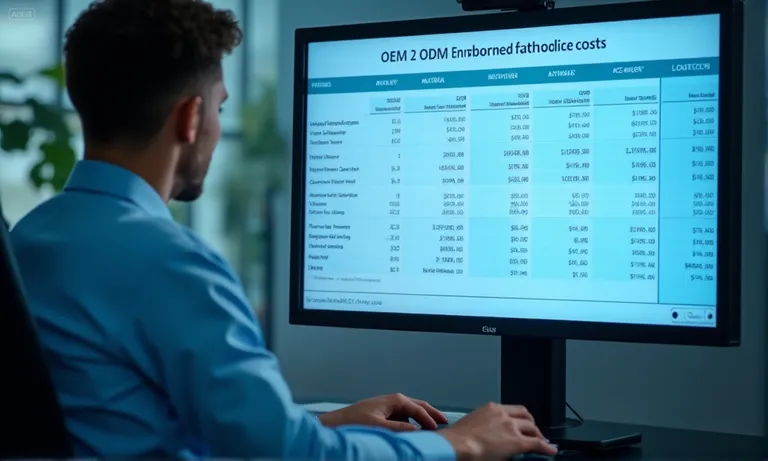Choosing the right production model for dental implants goes beyond cost—it defines how your business balances speed, customization, risk, and brand control. Every collaboration model with a dental lab carries long-term implications for product launch, scalability, and reputation.
OEM, ODM, and outsourcing each provide different trade-offs. OEM protects your intellectual property and brand identity but requires higher investment. ODM speeds up market entry with ready-made solutions, while outsourcing reduces upfront cost yet increases dependence on the supplier. The optimal choice depends on your goals, resources, and control requirements.
This guide highlights the core dimensions to evaluate:
- Roles & responsibilities: Control of design, IP, and branding
- Customization flexibility: Degree of product adaptation to your needs
- Cost structure & ROI: Pricing transparency and hidden risks
- Workflow & communication: Day-to-day collaboration requirements
- Risk & liability: Quality, rework, and compliance responsibility
- Decision framework: Aligning the right model with business growth plans
By structuring evaluation across these factors, procurement teams, distributors, and implant businesses can select the partnership model that maximizes long-term value and minimizes costly misalignment.
What are the core differences between OEM, ODM, and outsourcing?
A dental implant project can follow different cooperation models—OEM, ODM, and outsourcing—each defining distinct roles in design, production, and ownership. Understanding these differences helps procurement teams clarify who controls the intellectual property, how much customization is possible, and whether speed or long-term brand consistency is prioritized.

oem-vs-odm-vs-outsourcing-dental-implants
How does each model define roles in design, production, and IP ownership?
- OEM (Original Equipment Manufacturing): The buyer owns the design and IP. The lab focuses on production accuracy and volume. This model suits companies with strong R&D who want to protect their designs.
- ODM (Original Design Manufacturing): The lab designs and produces the implant under the buyer’s brand. IP rights may be shared or contractually transferred. ODM accelerates development for businesses without large in-house design teams.
- Outsourcing: The lab or vendor provides services on demand—such as CAD/CAM design or milling—without IP transfer. Responsibility is often limited to execution, and contracts define the scope.
How much customization, brand control, and flexibility does each model allow?
- OEM: Offers the highest customization and brand control, since all specifications come from the buyer. Flexibility is limited by the buyer’s ability to provide precise design inputs.
- ODM: Provides moderate customization—buyers can influence design but rely on the lab’s existing templates and expertise. Faster to launch, but brand differentiation is narrower.
- Outsourcing: Generally low customization, as the vendor delivers standardized services. Buyers have limited influence beyond job specifications.
Which model is better for speeding up time-to-market vs. ensuring long-term control?
- Time-to-market: ODM and outsourcing are faster because labs already have design frameworks and production capacity.
- Long-term control: OEM is better for companies prioritizing IP protection, brand differentiation, and scalability.
- Balanced approach: Some buyers mix models—for example, using ODM for pilot projects and shifting to OEM once demand stabilizes.
In summary, OEM secures IP and brand authority, ODM speeds market entry with design support, and outsourcing keeps processes lean for specific tasks. Many overseas dental labs, including collaborators like Raytops, adapt workflows to support hybrid strategies where different models coexist for different implant product lines. For a deeper explanation of how OEM components integrate into dental implant systems—including design integrity, material compatibility, and quality control—refer to this OEM Components in Dental Implant Restorations article.
How to align each model with your dental implant business needs?
The right cooperation model depends on your company’s business goals, buyer type, and growth trajectory. Dental implant products vary widely—from single posterior crowns to complex full-arch restorations—so aligning OEM, ODM, or outsourcing with specific needs ensures smoother execution.

dental-implant-business-alignment-oem-odm-outsourcing
When is OEM a better fit than ODM or outsourcing?
- OEM is best for established brands with in-house design capabilities who want full control over IP, quality standards, and scalability. It supports companies preparing to expand internationally where compliance and brand identity matter most.
- ODM works better for mid-sized buyers lacking design resources but aiming for faster launches with moderate customization.
- Outsourcing fits smaller clinics or distributors seeking to augment capacity without heavy investment.
Which model supports flexibility for small batch or custom implant cases?
- Outsourcing usually provides the greatest flexibility for small-batch or custom orders, avoiding MOQ constraints.
- ODM can offer semi-customized implant solutions when labs have pre-validated design libraries.
- OEM offers full control but is less flexible for small volumes due to setup costs.
How do buyer type and growth plans affect your model choice?
- Distributors or DSOs often prefer ODM to balance cost and speed across multiple clinics.
- Private dental practices may rely on outsourcing for occasional complex cases.
- Growth-oriented manufacturers generally adopt OEM once volumes justify IP protection and higher setup costs.
In reality, your business model should align with your product strategy, resource strength, and scalability needs. For insights on how dental service organizations (DSOs) optimize operational models for efficiency and growth, see this dental enterprise model article from Dental Economics.
What are the cost structures and pricing differences between models?
OEM, ODM, and outsourcing each structure costs differently, and for implant businesses, recognizing these differences is essential to protecting margins and avoiding hidden risks. A careful breakdown of upfront, ongoing, and hidden expenses provides the foundation for sound decision-making.

dental-implant-cost-structure-comparison
How are costs allocated in OEM, ODM, and outsourcing projects?
- OEM typically requires upfront investments in tooling, regulatory documentation, and long-term supplier contracts. Costs concentrate on design, validation, and IP control.
- ODM reduces upfront design expenses since the lab owns the design library, but customization or exclusivity rights may add premiums.
- Outsourcing usually operates on a per-case basis, with pricing tied to material selection, case complexity, and turnaround expectations.
Which model offers better cost predictability and margin control?
- OEM provides clearer long-term margin control once initial investments are amortized, but requires larger volume commitments.
- ODM balances predictability with speed, though buyers must consider licensing fees for semi-custom designs.
- Outsourcing gives short-term flexibility, though variability in case volume and remake rates can reduce predictability.
What hidden costs, licensing fees or MOQ risks should you consider?
- MOQ requirements in OEM may lock buyers into higher inventory costs.
- ODM contracts sometimes include licensing fees for proprietary designs or restrictions on geographic sales.
- Outsourcing can carry hidden costs such as remake shipping, communication overhead, and added admin time when coordinating multiple vendors. Over the lifecycle of collaboration, overall cost-effectiveness depends on quality consistency as much as unit price.
In practice, comparing models by total cost of ownership—upfront, operational, and risk-related—helps procurement teams choose arrangements that preserve margins while ensuring stable delivery.
How do collaboration and workflow differ across models?
Collaboration efficiency determines whether implant projects move smoothly across borders. OEM, ODM, and outsourcing each require different levels of coordination, which directly impacts how quickly cases move from design to delivery.

dental-lab-digital-collaboration-workflow
What level of communication and coordination does each model require?
- OEM partnerships demand deep coordination at the design stage, since the buyer owns the intellectual property. Regular meetings, detailed specifications, and strict change documentation are common.
- ODM reduces the need for heavy design dialogue, as the lab contributes pre-developed solutions. Communication focuses more on modifications, branding, and regulatory approval.
- Outsourcing generally has the lightest coordination burden, but the risk is higher: fewer checks mean miscommunication can lead to remakes or delays.
How do design file submissions and feedback loops work?
- In OEM models, buyers typically manage CAD/CAM file exchanges through secure digital platforms. These include version-controlled submissions, multiple review stages, and sign-offs before production.
- ODM workflows often leverage existing libraries, so digital submissions are shorter, but iteration speed depends on contract flexibility.
- In outsourcing, case files (often in STL format) are submitted on demand. Feedback loops can be fast, but lack of structure may affect consistency. Modern labs increasingly integrate with platforms such as Exocad to streamline revisions and digital collaboration.
Which model adapts better to urgent design changes or quick delivery cycles?
- OEM is the most stable but slowest to adapt, since any urgent change must be validated to protect IP and regulatory compliance.
- ODM offers moderate flexibility, balancing pre-existing frameworks with buyer input.
- Outsourcing adapts best to quick changes and smaller case volumes, provided the lab has robust SOPs for urgent revisions. This flexibility is particularly useful in implant dentistry, where last-minute adjustments can prevent chairside complications.
Ultimately, procurement teams should align workflow expectations with case complexity: OEM for control and consistency, ODM for balanced speed and customization, outsourcing for rapid adaptability.
What are the risk factors and responsibilities across cooperation models?
Risk management is central when choosing between OEM, ODM, and outsourcing for dental implants. Each model distributes quality, IP, and compliance responsibility differently, which directly affects procurement decisions and long-term partnerships.

dental-lab-quality-control-and-risk-management
How is quality control handled in each model, and who takes responsibility?
- OEM: The buyer defines QC standards, while the lab executes production. Responsibility is shared—any defect often traces back to either poor design documentation or inadequate lab execution.
- ODM: Since the lab contributes design and manufacturing, it assumes a larger share of QC responsibility. This can reduce buyer burden, but requires trust in the lab’s documented SOPs.
- Outsourcing: Quality risk is highest here, since the lab mainly executes orders without structural involvement. Without strict QA agreements, inconsistencies and higher remake rates may occur.
What level of IP protection and contract enforcement can you expect?
- OEM requires strong intellectual property agreements, as buyers typically provide proprietary designs. Non-disclosure agreements and clear contract language are essential.
- ODM involves shared design ownership, which introduces gray areas. Buyers should clarify IP transfer clauses before collaboration.
- Outsourcing usually has minimal IP exposure, but contracts must still define liability for remakes, confidentiality, and data handling.
What due diligence steps should be taken before finalizing the model?
- Review certifications such as ISO 13485 for medical device quality management.
- Request process documentation that tracks lot numbers, material sourcing, and QA records.
- Verify regulatory compliance in target markets (e.g., CE MDR in Europe, FDA requirements in the U.S.).
- Conduct pilot projects before scaling, to measure defect rates and evaluate real collaboration workflows.
In dental implant partnerships, risk is not only about product defects but also about documentation gaps, IP conflicts, and compliance failures. Choosing the right model requires balancing these risks against the level of control a buyer wants to retain.
What’s a practical framework for choosing the right model?
Selecting between OEM, ODM, and outsourcing is rarely about one single factor. A structured framework helps decision makers weigh customization, cost, speed, risk, and control in a way that aligns with business strategy and market expectations.

decision-matrix-for-dental-implant-business-models
How to compare customization, cost, speed, risk, and control factors?
A decision matrix can make trade-offs clear:
| Factor | OEM | ODM | Outsourcing |
|---|---|---|---|
| Customization | High (buyer-driven) | Medium (lab-driven) | Low |
| Cost Predictability | High (design fixed) | Medium | Variable |
| Speed to Market | Moderate | Fast | Very fast but less control |
| Risk Exposure | Shared but contract-heavy | Moderate with IP overlap | High if QC not enforced |
| Control Level | Strong | Medium | Weak |
This framework clarifies that OEM favors control, ODM balances speed and innovation, while outsourcing prioritizes low upfront commitment but with more risks.
Can you combine different models for different product lines?
Yes. A growing number of dental businesses apply hybrid strategies:
- Use OEM for high-value implant systems that require strict IP and brand control.
- Apply ODM for mid-range implant-supported prosthetics where labs bring proven design expertise.
- Reserve outsourcing for overflow capacity, low-margin items, or temporary market testing.
Such blended use reduces risk concentration and allows flexibility across diverse clinical demands.
What decision tools or frameworks can support structured selection?
- SWOT analysis to compare models against internal capabilities.
- Risk assessment checklists from regulatory bodies like the FDA to evaluate compliance gaps.
- Pilot runs with a chosen lab partner to test workflow speed and remake rates before committing to full-scale collaboration.
By applying structured frameworks, procurement teams avoid over-relying on cost alone. Instead, they ensure that business needs, clinical safety, and long-term value all align with the cooperation model selected.
Conclusion
Choosing the right cooperation model—OEM, ODM, or outsourcing—defines how much control, flexibility, and risk you carry in dental implant projects. OEM secures brand identity and intellectual property, ODM accelerates speed with proven designs, while outsourcing offers quick entry but higher risk exposure.
For dental businesses, the most successful partnerships balance cost with quality assurance, customization with compliance, and efficiency with long-term stability. Working with an experienced overseas dental lab ensures that whichever model you select, workflows remain predictable, documentation is transparent, and remake risks are minimized.
By applying structured evaluation and selecting trustworthy partners, procurement teams can align implant projects with both immediate market needs and long-term business growth.


